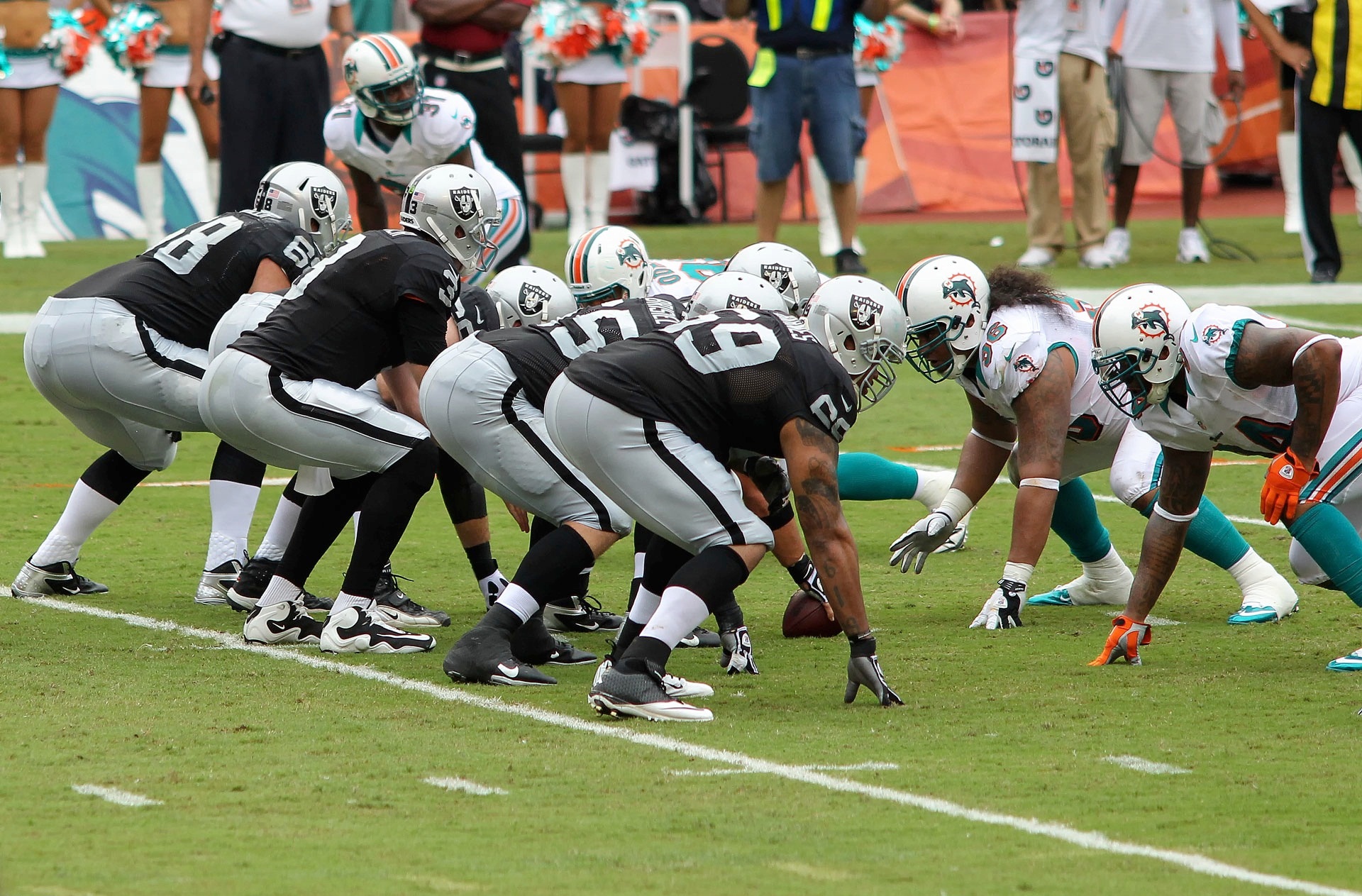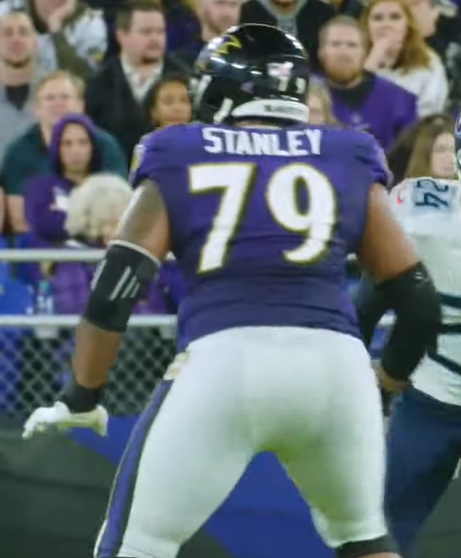Tackle (gridiron football position) on:
[Wikipedia]
[Google]
[Amazon]

 A tackle is a playing position in
A tackle is a playing position in
 The ''left tackle'' (''LT'') is usually the team's best pass blocker. Of the two tackles, the left tackles will often have better footwork and agility than the right tackle in order to counteract the pass rush of defensive ends. When a quarterback throws a forward pass, the quarterback's shoulders are aligned roughly perpendicular to the line of scrimmage, with the non-dominant shoulder closer to downfield. The vast majority of quarterbacks are right-handed, so they turn their backs to defenders coming from the left side, creating a vulnerable "blind side" that the left tackle must protect. (Conversely, teams with left-handed quarterbacks tend to have their better pass blockers at right tackle for the same reason.)
A 2006 book by Michael Lewis, '' The Blind Side: Evolution of a Game'', made into a 2009 motion picture, shed light on the workings of the left tackle position. The book and the film's introduction discuss how the annual salary of left tackles in the NFL skyrocketed in the mid-1990s. Premier left tackles are now highly sought after and are often the second highest paid players on a roster after the quarterback; in the 2013 NFL draft three of the first four picks were left tackles, and usually at least one left tackle is picked in the first five positions. Recent examples include Joe Alt (2024, 5th overall pick), Andrew Thomas (2020, 4th overall pick), Brandon Scherff (2015, 5th overall pick), Eric Fisher (2013, 1st overall pick), Luke Joeckel (2013, 2nd overall pick), Lane Johnson (2013, 4th overall pick), Matt Kalil (2012, 4th overall pick), Trent Williams (2010, 4th overall pick), and Jake Long (2008, 1st overall pick).
The ''left tackle'' (''LT'') is usually the team's best pass blocker. Of the two tackles, the left tackles will often have better footwork and agility than the right tackle in order to counteract the pass rush of defensive ends. When a quarterback throws a forward pass, the quarterback's shoulders are aligned roughly perpendicular to the line of scrimmage, with the non-dominant shoulder closer to downfield. The vast majority of quarterbacks are right-handed, so they turn their backs to defenders coming from the left side, creating a vulnerable "blind side" that the left tackle must protect. (Conversely, teams with left-handed quarterbacks tend to have their better pass blockers at right tackle for the same reason.)
A 2006 book by Michael Lewis, '' The Blind Side: Evolution of a Game'', made into a 2009 motion picture, shed light on the workings of the left tackle position. The book and the film's introduction discuss how the annual salary of left tackles in the NFL skyrocketed in the mid-1990s. Premier left tackles are now highly sought after and are often the second highest paid players on a roster after the quarterback; in the 2013 NFL draft three of the first four picks were left tackles, and usually at least one left tackle is picked in the first five positions. Recent examples include Joe Alt (2024, 5th overall pick), Andrew Thomas (2020, 4th overall pick), Brandon Scherff (2015, 5th overall pick), Eric Fisher (2013, 1st overall pick), Luke Joeckel (2013, 2nd overall pick), Lane Johnson (2013, 4th overall pick), Matt Kalil (2012, 4th overall pick), Trent Williams (2010, 4th overall pick), and Jake Long (2008, 1st overall pick).

American football
American football, referred to simply as football in the United States and Canada and also known as gridiron football, is a team sport played by two teams of eleven players on a rectangular American football field, field with goalposts at e ...
. Historically, in the one-platoon system prevalent in the late nineteenth and early twentieth centuries, a tackle played on both offense and defense
Defense or defence may refer to:
Tactical, martial, and political acts or groups
* Defense (military), forces primarily intended for warfare
* Civil defense, the organizing of civilians to deal with emergencies or enemy attacks
* Defense industr ...
. In the modern system of specialized units, offensive tackle and defensive tackle
A defensive tackle (DT) is a position in American football that typically lines up on the line of scrimmage, opposite one of the Guard (American football), offensive guards; however, he may also line up opposite one of the offensive Tackle (gridir ...
are separate positions, and the stand-alone term "tackle" refers to the offensive tackle position only. The offensive tackle (OT, T), sometimes specified as left tackle (LT) or right tackle (RT), is a position on the offensive line that flanks the two guards. Like other offensive linemen, their objective is to block during each offensive play, physically preventing defenders from tackling or disrupting the offensive ball carrier with the intention of advancing the football downfield.
A tackle is the strong position on the offensive line. They power their blocks with quick steps and maneuverability. The tackles are mostly in charge of the outside protection. Usually they defend against defensive ends, but they do also have to defend against defensive tackle
A defensive tackle (DT) is a position in American football that typically lines up on the line of scrimmage, opposite one of the Guard (American football), offensive guards; however, he may also line up opposite one of the offensive Tackle (gridir ...
s, especially if the corresponding guard on their side pulls. In the NFL, offensive tackles often measure over and . Offensive tackles are generally the tallest and heaviest players in football.
According to ''Sports Illustrated
''Sports Illustrated'' (''SI'') is an American sports magazine first published in August 1954. Founded by Stuart Scheftel, it was the first magazine with a circulation of over one million to win the National Magazine Award for General Excellen ...
'' football journalist Paul Zimmerman, offensive tackles consistently achieve the highest scores, relative to the other positional groups, on the Wonderlic Test, with an average of 26. The Wonderlic is taken before the draft to assess each player's aptitude for learning and problem solving.
The distinction between right and left tackle has become less relevant.
Right tackle
The ''right tackle'' (''RT'') is typically one of the team's most effective run blockers. Since most running plays are directed towards the strong side (the side with thetight end
The tight end (TE) is an offense (sports), offensive position in American football, arena football, and Canadian football. It is a hybrid that combines the characteristics and roles of both an offensive lineman and a receiver (football), receiv ...
) of the offensive line, the right tackle often contends with the defending team's best run stoppers. They must be capable of gaining traction in their blocks to impede defenders from tackling the ball carrier or create a hole—an area between offensive lineman that forms immediately after the ball is snapped. This is a result of blocking strategies and techniques, generating enough space for the ball carrier to run between and advance the ball.
Left tackle
 The ''left tackle'' (''LT'') is usually the team's best pass blocker. Of the two tackles, the left tackles will often have better footwork and agility than the right tackle in order to counteract the pass rush of defensive ends. When a quarterback throws a forward pass, the quarterback's shoulders are aligned roughly perpendicular to the line of scrimmage, with the non-dominant shoulder closer to downfield. The vast majority of quarterbacks are right-handed, so they turn their backs to defenders coming from the left side, creating a vulnerable "blind side" that the left tackle must protect. (Conversely, teams with left-handed quarterbacks tend to have their better pass blockers at right tackle for the same reason.)
A 2006 book by Michael Lewis, '' The Blind Side: Evolution of a Game'', made into a 2009 motion picture, shed light on the workings of the left tackle position. The book and the film's introduction discuss how the annual salary of left tackles in the NFL skyrocketed in the mid-1990s. Premier left tackles are now highly sought after and are often the second highest paid players on a roster after the quarterback; in the 2013 NFL draft three of the first four picks were left tackles, and usually at least one left tackle is picked in the first five positions. Recent examples include Joe Alt (2024, 5th overall pick), Andrew Thomas (2020, 4th overall pick), Brandon Scherff (2015, 5th overall pick), Eric Fisher (2013, 1st overall pick), Luke Joeckel (2013, 2nd overall pick), Lane Johnson (2013, 4th overall pick), Matt Kalil (2012, 4th overall pick), Trent Williams (2010, 4th overall pick), and Jake Long (2008, 1st overall pick).
The ''left tackle'' (''LT'') is usually the team's best pass blocker. Of the two tackles, the left tackles will often have better footwork and agility than the right tackle in order to counteract the pass rush of defensive ends. When a quarterback throws a forward pass, the quarterback's shoulders are aligned roughly perpendicular to the line of scrimmage, with the non-dominant shoulder closer to downfield. The vast majority of quarterbacks are right-handed, so they turn their backs to defenders coming from the left side, creating a vulnerable "blind side" that the left tackle must protect. (Conversely, teams with left-handed quarterbacks tend to have their better pass blockers at right tackle for the same reason.)
A 2006 book by Michael Lewis, '' The Blind Side: Evolution of a Game'', made into a 2009 motion picture, shed light on the workings of the left tackle position. The book and the film's introduction discuss how the annual salary of left tackles in the NFL skyrocketed in the mid-1990s. Premier left tackles are now highly sought after and are often the second highest paid players on a roster after the quarterback; in the 2013 NFL draft three of the first four picks were left tackles, and usually at least one left tackle is picked in the first five positions. Recent examples include Joe Alt (2024, 5th overall pick), Andrew Thomas (2020, 4th overall pick), Brandon Scherff (2015, 5th overall pick), Eric Fisher (2013, 1st overall pick), Luke Joeckel (2013, 2nd overall pick), Lane Johnson (2013, 4th overall pick), Matt Kalil (2012, 4th overall pick), Trent Williams (2010, 4th overall pick), and Jake Long (2008, 1st overall pick).
References
{{Authority control American football offensive linemen American football positions